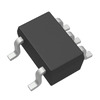Manufacturer Part Number
TLV1702AIDGKR
Manufacturer
Texas Instruments
Introduction
The TLV1702AIDGKR is a dual general-purpose linear comparator, designed for use in applications requiring low-voltage and low-current operations.
Product Features and Performance
Dual comparator configuration
Compatible with low-voltage operations
Supports wide range of power supplies
Low input offset voltage, ensuring precision
Low input bias current
High output current capability
Low quiescent current for power efficiency
Maximized propagation delay for quick response times
Compact 8-TSSOP, 8-MSOP package enabling space-saving designs
Extended operating temperature range for harsh environments
Product Advantages
Energy-saving for battery-powered devices
High precision for critical monitoring tasks
Robust design suitable for industrial applications
High integration to minimize board space
Key Technical Parameters
Number of Elements: 2
Output Type: Open-Collector
Voltage - Supply, Single/Dual (±): 2.2V to 36V, ±1.1V to 18V
Voltage - Input Offset (Max): 3.5mV
Current - Input Bias (Max): 0.015µA
Current - Output (Typ): 20mA
Current - Quiescent (Max): 75µA
Propagation Delay (Max): 560ns
Operating Temperature: -40°C to 125°C
Quality and Safety Features
Reliable operation within specified temperature range
Manufactured by Texas Instruments, known for quality and performance
Compatibility
Surface mount for easy integration into various circuit designs
Suitable for a range of power supply configurations
Application Areas
Industrial monitoring systems
Automotive sensors and controls
Consumer electronics
Data acquisition systems
Power management systems
Product Lifecycle
Product Status: Active
Not reported as nearing discontinuation
Availability of replacements or upgrades should be verified with the manufacturer as product lifecycle progresses
Several Key Reasons to Choose This Product
Low power consumption ideal for portable and remote devices
Texas Instruments’ reputation for reliable and durable components
High precision and speed for critical application requirements
Flexibility in power supply choices for diverse designs
The small form factor accommodating tight PCB layouts



 TLV1701IDBVRTexas Instruments
TLV1701IDBVRTexas Instruments TLV1702AIRUGRTexas InstrumentsIC COMPARATOR 2 GEN PUR 8X2QFN
TLV1702AIRUGRTexas InstrumentsIC COMPARATOR 2 GEN PUR 8X2QFN TLV1701AIDCKRTexas InstrumentsIC COMPARATOR 1 GEN PUR SC70-5
TLV1701AIDCKRTexas InstrumentsIC COMPARATOR 1 GEN PUR SC70-5 TLV1701AIDRLTTexas InstrumentsIC COMPARATOR 1 GEN PUR SOT5
TLV1701AIDRLTTexas InstrumentsIC COMPARATOR 1 GEN PUR SOT5 TLV170IDBVRTexas InstrumentsIC OPAMP GP 1 CIRCUIT SOT23-5
TLV170IDBVRTexas InstrumentsIC OPAMP GP 1 CIRCUIT SOT23-5 TLV1701QDBVRQ1Texas InstrumentsIC COMPARATOR 1 GEN PUR SOT23-5
TLV1701QDBVRQ1Texas InstrumentsIC COMPARATOR 1 GEN PUR SOT23-5